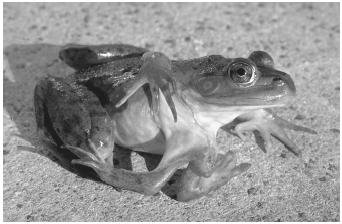Mutation
Any heritable change in the genetic information or DNA is called a mutation. A change in the base sequence of DNA that is then replicated and transmitted to future generations of cells becomes a permanent change in the genome . Mutations, all of which appear to occur as random events, can range from a single replacement of a base (substitution) to larger changes that result from the deletion or addition of more than one base (often large stretches of a DNA molecule).
Most mutations are thought to be harmful to the life of the cell. These harmful mutations occur during the development of a cancer cell, for example. In these cases (cancerous transformation), numerous point mutations or deletion mutations are well-established as causative agents. A point mutation

occurs when a single base is changed in a DNA sequence. This can be either: (1) a transition, in which a purine base is replaced by another purine base, or pyrimidine by pyrimidine (e.g., base pair AT becomes base pair GC); or (2) a transversion, in which a purine is replaced by a pyrimidine, or vice versa (e.g., base pair AT becomes base pair CG). A point mutation that changes a codon with the result that it codes for a different amino acid is called a missense mutation. Such a mutation can change the nature of the protein being formed. It can change the amino acid composition and the protein sequence and, therefore, the structure of that protein. This process may have a deleterious effect on protein activity in essential metabolic functions in the cell. In contrast, there are cases in which a mutation can change the protein sequence but have little or no consequence on the protein function. These are silent mutations. In these cases, the change is a conservative one (a single amino acid is substituted for another of similar type, such as lysine for an arginine, or the amino acid residue may reside on the outside surface of the protein where it will have little effect on protein structure). Such silent mutations exhibit no phenotypic (observable) changes. Alternatively, a mutation can occur in intergenic or noncoding regions and thus have no direct effect on the protein product. There can also be rare changes in DNA sequence that may provide a selective advantage to an organism.
Mutations may occur spontaneously, or as a result of external physical agents (radiation) or chemical agents (mutagens). The most common spontaneous mutations result from errors in DNA replication that are not corrected. Virtually all forms of life are exposed to ultraviolet light from the Sun, which can react with adjacent thymine bases in DNA in such a way as to link them together to produce an intrastrand thymine dimer. A number of chemicals, including dimethylsulfate, nitrous acid, and nitrogen mustards, react with bases in DNA so as to modify them. As a result, the subsequent replication cycle changes the complementary base or bases and leads to a permanent change in the form of a transition or transversion. In the case of the thymine dimers or the loss of a base, repair enzymes exist that scan the DNA in an attempt to correct the problem. There are a number of inherited disease conditions, such as xeroderma pigmentosum and Cockayne syndrome, that result from defects in genes associated with DNA repair.
In a number of cancers, a deletion of much or all of a gene that completely inactivates the gene has occurred. It is claimed that about 80 percent of human cancers may be caused by carcinogens that damage DNA or interfere with its replication and/or repair. Bruce Ames, a microbiologist at the University of California at Berkeley, developed a simple experimental procedure using bacterial cells that can detect mutagenic chemicals. It has been shown that about 80 percent of carcinogenic compounds are also mutagenic using the Ames test.
Bibliography
Fairbanks, Daniel J., and Andersen, W. Ralph (1999). Genetics: The Continuity of Life. Pacific Grove, CA: Brooks/Cole Publishing.
Nelson, David L., and Cox, Michael M. (2000). Lehninger Principles of Biochemistry, 3rd edition. New York: Worth Publishers.
Comment about this article, ask questions, or add new information about this topic: